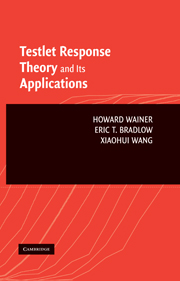Book contents
- Frontmatter
- Contents
- Preface
- PART I INTRODUCTION TO TESTLETS
- PART II BAYESIAN TESTLET RESPONSE THEORY
- 7 A brief history and the basic ideas of modern testlet response theory
- 8 The 2-PL Bayesian testlet model
- 9 The 3-PL Bayesian testlet model
- 10 A Bayesian testlet model for a mixture of binary and polytomous data
- 11 A Bayesian testlet model with covariates
- 12 Testlet nonresponse theory: dealing with missing data
- PART III TWO APPLICATIONS AND A TUTORIAL
- Glossary of terms
- Epilogue
- Bibliography
- Author Index
- Subject Index
11 - A Bayesian testlet model with covariates
Published online by Cambridge University Press: 08 January 2010
- Frontmatter
- Contents
- Preface
- PART I INTRODUCTION TO TESTLETS
- PART II BAYESIAN TESTLET RESPONSE THEORY
- 7 A brief history and the basic ideas of modern testlet response theory
- 8 The 2-PL Bayesian testlet model
- 9 The 3-PL Bayesian testlet model
- 10 A Bayesian testlet model for a mixture of binary and polytomous data
- 11 A Bayesian testlet model with covariates
- 12 Testlet nonresponse theory: dealing with missing data
- PART III TWO APPLICATIONS AND A TUTORIAL
- Glossary of terms
- Epilogue
- Bibliography
- Author Index
- Subject Index
Summary
Chapters 7 to 10 provide a thorough introduction to a family of Bayesian-based testlet response models that will allow for the appropriate scoring of a broad range of tests. Yet, there remains one major theoretical hill to climb, as well as a minor technical one. In particular, while the model described in Chapter 10 allows us to model data composed of binary items, polytomous items, nested inside or outside of testlets, it does not help us explain “why” we observe what we do. This is our mission here.
Before we explicitly describe our approach, we note that for many practical situations, understanding the “why” may or may not be important. For the “is not important side,” we can state that many tests are simply used as measurement devices, and what is important is that the device reliably measures the ability and item parameters as well as possible. A Bayesian mixed TRT model allows one to get “honest” estimates of examinee ability that integrates both multiple-choice and essay-like formats, and assumes conditional independence after incorporating the testlet structure. One does not need a theory or method of understanding “why” to answer this question. Pure measurement does not require a “why.”
On the other hand, it is easy to imagine many settings where being able to understand “why” from a psychometric model is of primary interest.
- Type
- Chapter
- Information
- Testlet Response Theory and Its Applications , pp. 154 - 185Publisher: Cambridge University PressPrint publication year: 2007



